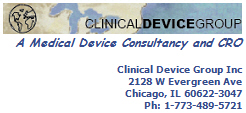Safety, Efficacy, or Performance
Your firm's product line is probably built around one or more distinct technologies, be it cardiology, wound care, neuroelectrical or muscle stimulation, neonatal care, diagnostics, imaging, or whatever. You understand how your technology works, that's not the issue, but if you have read this far you are probably looking for technical assistance in establishing safety, efficacy, or performance. About one-third of our business is focused on evaluating biological safety, one-third is focused on clinical research, and one-third is focused on training.
Biocompatibility Risk Assessment, ISO 10993 Biological Safety
I like to joke that clients have only three questions regarding biological safety: 1) have I done enough testing, 2) do I have to do genotoxicity and/or carcinogenicity testing, and 3) my material failed a test, can I use it anyway? There are a hundred variations on these questions, but the theme is constant, what testing do I have to do and have I done enough already. A good deal of our work is evaluating the test results that manufacturers already have and writing expert reports as to their adequacy or making recommendations to fill in the gaps. Other biological safety work involves responding to FDA questions, reviewing specific test results, or other related work.
Consultancy and CRO Capabilities
Text in progress...............
Clinical Evaluations for the EU
When Europe adopted the GHTF Study Group 5 document on clinical evaluations and reissued MEDDEV 2.7.1 rev3 "Guidelines on Medical Devices. Evaluation of Clinical Data...." they paved the way for commercializing devices in Europe via the literature route. The purpose of a clinical evaluation is to demonstrate safety and performance based on already existing data, thus obviating the need for new clinical investigations.
Think of a clinical evaluation as a three-legged stool: 1) an evaluation of the published literature, 2) an evaluation of clinical investigations sponsored by the manufacturer, and 3) an evaluation of the complaint history and risk management system for the device. These three sub-evaluations are put together to form an arguement for safety and performance of the device for its stated intended use.
Clinical evaluations require a team of people to be executed properly. You need a lead medical writer who will orchestrate the tasks, assess the data, and write the evaluation, an information specialist to design and execute the literature searches, a statistician to assess the statistical validity of the data, and optionally, a physician or medical specialist for an overall review. CDG has a proven track record in writing clinical evaluations that are accepted by Notified Bodies.
Regulatory Strategies and 510(k) Submissions
You designed a technology with the idea that it could do something medically useful. A regulatory strategy begins with expressing that usefulness in a single statement of intended use. Think of verbs: the technology stimulates, ablates, relieves, manages, supports, controls, prevents, interrupts, monitors, or measures; in other words what does the technology do?
The next step is to identify the diseases and conditions for which the investigational device* will be used. For example, it stimulates nerves to operates artificial limbs, it ablates soft tissue for body sculpting, it relieves pain by preventing air from contacting the wound, and so forth.
Then you will need to obtain the product code for the investigational device. Product codes, sometimes called classification numbers even though the codes consist of three letters, are the key identification code by which FDA organizes all of its databases. You need the product code in order to search for suitable predicate devices. A predicate device is one to which the investigational device is substantially equivalent and that was legally marketed in the US prior to May 28, 1976.
A 510(k) is a submission to FDA arguing that the investigational device is substantially equivalent to one or more predicate devices. If FDA "clears" the 510(k) submission you may commercialize your device. CDG has Network Staff Associates with proven track records in preparing regulatory strategies and crafting 510(k) submissions.
*All devices are investigational until they are cleared or approved, whether or not a clinical investigation is planned.
Protocol Design, Study Design
If the intended use is a verb that identifies the purpose of the technology, and the indications for use are the diseases and conditions that will be treated, then the claims are a measure of performance. For example, "easier to use", "stronger", "better torque", "absorbs exudate leaving the wound bed moist", or "whitens teeth" are claims—assertions of truth—that imply performance based on data that probably came from a clinical investigation.
It follows that protocol and study design begin with the claims and indications you want to make for the investigational device. Together, the claims and indications will be crafted into the primary and secondary hypotheses and the primary and secondary endpoints or primary and secondary outcomes. Finding a reliable method for measuring the endpoint or outcome will be the most difficult challenge.
From here the protocol will fall naturally into place. CDG has several Network Staff Associates who can review your existing protocol or help you write a new protocol that includes all the ISO 14155 elements, meets 21 CFR Part 812 requirements, and is logical and executable.
IVD Study Designs
In-vitro diagnostic devices begin at the same starting point with claims and indications for use, but they require a family of "clinical" studies to check for manufacturability as well as performance. Not everyone likes to call these studies "clinical" studies, because they use human tissue samples rather than humans themselves. The switch from humans to tissue samples causes the writer to rethink every regulation.
Sample Size Calculations
Text in progress...............
Project Management
Text in progress...............
Regulation of Human Investigations
Text in progress...............
Monitoring
Text in progress...............
Data Monitoring Boards
Text in progress...............
Data Management, Database Design
Text in progress...............
Statistical Analysis
Text in progress...............
Site and Sponsor Audits
Text in progress...............
Design Control Audits
Text in progress...............
Clinical Research Quality Management Systems
Text in progress...............
